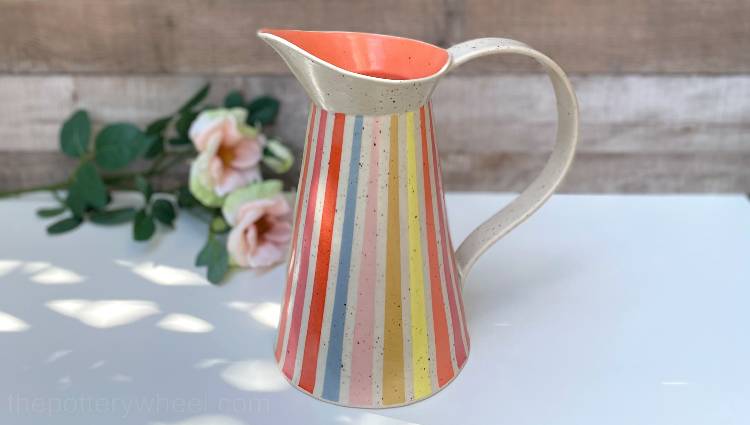Your cart is currently empty!
Is Stoneware Microwave Safe? Or is it Too Hot to Handle?
Published:
Last Updated:
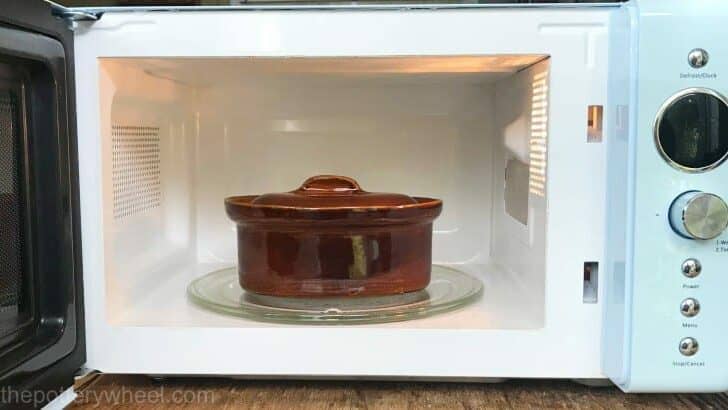
Affiliate Disclaimer
As an affiliate, we may earn a commission from qualifying purchases. We get commissions for purchases made through links on this website from Amazon and other third parties.
Before you heat something in the microwave, it’s always a good idea to check if the dish is microwave safe. But what about stoneware? Stoneware is one of the most commonly used ceramic materials for kitchen and dinnerware. But is stoneware microwave safe?
The short answer is ‘yes’, commercially made stoneware that has a ‘microwave safe’ label on the base, is fine to use in the microwave. However, do monitor whether your stoneware dishes get hot in the microwave when they get older, as they can become less microwave safe with wear and tear. Also imported stoneware may not cope as well in the microwave, even if it’s labeled microwave safe.
To be completely safe when deciding whether to put your ceramics into the microwave, it’s important to be aware of a few crucial things. This article covers exactly what you need to know to take care of your stoneware and protect your microwave.
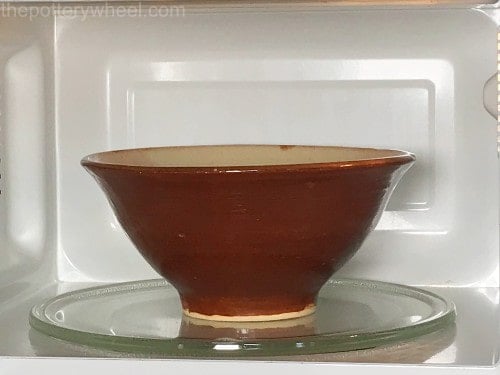
What Does Microwave Safe Actually Mean?
There is no standardized legal definition of what ‘microwave safe’ means. Usually, the term microwave safe is taken to mean one or all of the following:
- That the item won’t break, crack, shatter, melt, or generally be damaged through use in the microwave.
- Equally, the microwave won’t be damaged by the container being used.
- No toxic substances will be transferred, or ‘leached’ from the container into the food when it’s heated in the microwave.
- The container won’t become so hot that it will cause burns when picked up.
These are all fairly common-sense features of what microwave safety means. And when manufacturers label their ceramics microwave safe, it is these criteria that the user usually assumes will be met by the item in question.
Whilst there isn’t a formal legal definition of microwave safety, the FDA does include ceramics as being suitable for use in the microwave. Provided it has been labeled as such by the manufacturer.
But what does this mean for stoneware, and is stoneware microwave safe, according to the above criteria? Let’s take a closer look at how stoneware measures up…
What Exactly is Stoneware?
Stoneware is a particular kind of ceramic material. Broadly speaking ceramics and pottery can be classified into 3 categories. They include:
- Earthenware
- Stoneware
- Porcelain
One of the key differences between these different types of ceramics is to do with how porous they are. Pores are the spaces in a material, a bit like the holes in a sponge. The more porous a material the more holes there are throughout it.
Porous materials will absorb water when, for example, they are washed or used to contain liquids.
Earthenware is usually more porous than stoneware or porcelain. Typically, earthenware is defined as fired clay that has a porosity of 5% or over (Hamer and Hamer, 2015, p123).
By contrast, stoneware ceramics will usually have a porosity of between 1 and 2% and sometimes lower. This means that it absorbs less water than earthenware clay when it gets wet. If you want to know more about exactly what stoneware is, you can have a look at my complete guide to stoneware here.
This is relevant when it comes to microwave safety because of how microwaves work.
How Do Microwaves Work?
Microwave ovens produce a kind of energy called electromagnetic waves. These micro (or small) waves are reflected around the inside of the oven cavity and are absorbed by food.
The waves make the water molecules in food vibrate. And it is the vibrating water that makes creates the heat which cooks the food.
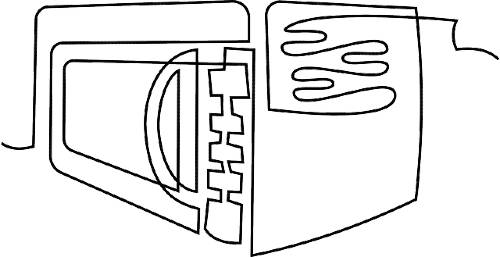
What Does This Mean for Stoneware Ceramics?
If the container that you are cooking your food in has also absorbed a lot of moisture, then it will get hot too.
So, very porous ceramics that have absorbed water from the dishwasher or the food and drink it contains will also become hot.
This can make it uncomfortable to lift the container out of the microwave after the food has been cooked.
But also, when water that has been absorbed into a ceramic dish becomes hot, it can put the dish under stress too. As the water heats up, it expands putting the dish under internal pressure.
If this happens repeatedly, it can affect the strength of the pottery and cause cracks. It can also cause the glazed surface of the pottery to separate from the ceramic body.
Luckily, stoneware has such low porosity, it is generally considered to be non-porous. This means that it doesn’t encounter the problem of absorbed water heating up in the ceramic walls.
A Word of Caution
Although stoneware is non-porous and water becoming hot in the walls of the pottery is not an issue, there are two things to watch out for…
1) Look Out for Chips and Cracks
Make sure that the stoneware does not have any cracks or chips in it. If water has seeped into a crack or chip in a piece of stoneware, then using a microwave to heat your food or drink may worsen the damage.
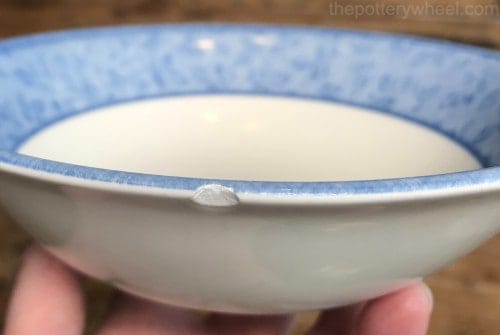
This can be dangerous, for example, if there is a crack in the joint where a handle meets a mug. The join can weaken over time through continual heating in the microwave.
So, it’s best to do a quick visual inspection of your stoneware before heating your food in the microwave.
2) Is the Stoneware Porous?
Stoneware is only non-porous if it has been made well. To have low porosity stoneware clay needs to be fired to the right temperature by the manufacturer.
This ranges from between 2157F (1186C) and 2232F (1222C). Sometimes stoneware clay is fired all the way up to 2381F(1305C).
If the stoneware hasn’t been fired to a hot enough temperature and the clay has not become fully mature, then it will not be watertight.
When ceramics have been made by a reputable manufacturer, then this is very unlikely to be an issue.
However, if you are buying handmade stoneware pottery from a smaller setup, then it’s a good idea to check with the maker that their pottery is ok to heat in the microwave.
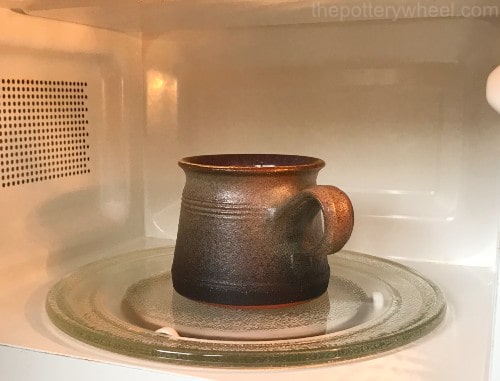
You could even impress them by asking them how porous their ceramics are! If the pottery has 1-2% porosity, then you are good to go. Or are you? Let’s take a look at some of the other issues that can affect microwave safety…
Other Concerns about Using Stoneware in a Microwave
What are the other things to consider when using stoneware in a microwave?
Metals In Your Ceramics
One of the commonly accepted limitations of using a microwave is that you should not put metal in the microwave.
However, stoneware clay and ceramics do contain traces of some metals such as iron. In addition to this, ceramic ware used for heating and consuming food and drink is normally coated with glaze.
Glaze is the glass-like coating that covers the underlying ceramic body. Some glazes used to seal and decorate pottery, also contain small quantities of metal too.
So, what does this mean?
It’s sometimes thought that the presence of trace metals in stoneware makes it unsafe to use in the microwave. However, this is not actually the case, and here is why…
What Happens When Metal is Put into a Microwave?
Microwave manuals invariably state that you should not put metal in them. The reason for this is that metal reflects electromagnetic waves rather than absorbing them. When the waves are reflected, they bounce around the microwave cooking chamber (source).
Sometimes these reflected waves can damage the microwave itself. Also, if electromagnetic waves hit a thin or pointy piece of metal like the edge of a piece of foil it can cause arcs of electricity to spark in the microwave.
These arcs can also damage the magnetron, which is the device in the microwave that creates the electromagnetic waves that cook your food.
However, trace metals in stoneware are present in small enough quantities that they are not problematic.
Some stonewares can contain higher amounts of metal. For example, red stoneware can contain 4-5% iron (source). But, for most stoneware clays, the percentage of trace metal content is lower.
These trace metals can have two consequences:
- Firstly, they can heat up whilst the microwave is being used, making the stoneware warm to the touch. However, if the manufacturer has made the ceramics to be used in the microwave, then the heat created in this way will not be sufficient to cause burns.
- Secondly, the sparks of electricity are created when the waves hit thin and pointed pieces of metal. Any trace metals in the stoneware would not be concentrated enough to cause electrical arcs.
A Word of Caution
Whilst the trace metals in stoneware or stoneware glazes are not generally an issue, there are certain metallic glaze decorations that should not go in the microwave. An example of this is a metallic glaze called luster. This kind of decoration is often used on more ornate ceramics like bone china.
These glazes are made of metal powder suspended in a liquid that is applied to small areas of the ceramic ware to create a lavish decorative touch. However, they can cause sparks, and whilst this is not dangerous for you, it can damage the microwave (source).
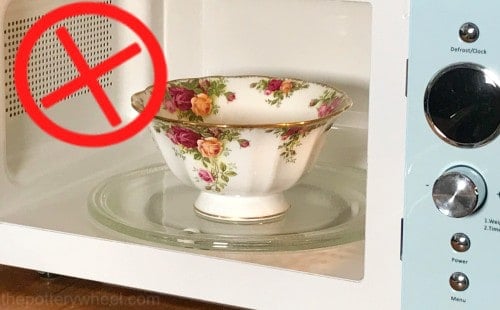
Also, some speckled stoneware ceramics have high iron content. If you are using speckled dinnerware, it’s always best to check with the manufacturer about whether it is safe to use in the microwave.
What About the Leaching of Toxins into Food?
Leaching refers to when metals are transferred from pottery glaze into the food or drink it contains. All glazes are a little soluble, so, a tiny bit of leaching is unavoidable. And some glazes are more soluble than others (source).
If you would like to know more about the ingredients of pottery glaze you can have a look at my article on that subject here.
The FDA has standards about what levels of leaching are safe or not. And ceramics manufacturers are obliged to follow those guidelines.
When ceramics are labeled as microwave safe, generally this means that when they are used to heat food, the microwaving process won’t cause harmful levels of leaching.
The problem is that not all ceramics are made to meet these FDA standards. Many ceramics and items of stoneware are imported from other countries that may not have the same rigorous levels of testing.
An example highlighted by the FDA is the presence of lead in glazes used on some imported Mexican pottery. A report by the FDA found that some of this imported pottery contained unsafe levels of extractable lead (source).
Nevertheless, this pottery had been labeled ‘lead-free’. The point is that you can’t always trust the labels that you read on ceramics, especially if you don’t know where it has been produced.
And the same goes for a label that states stoneware is microwave safe. Given that there is no legal definition of what it means to be microwave safe, it’s good to exercise a bit of caution.
Does Using a Microwave Cause Leaching in Stoneware?
The question is, if you use a microwave to heat your food, does it increase the chances that your stoneware will leach toxins?
This is an important question and Good House Keeping (GHK) did an interesting bit of research into exactly that subject. They tested a selection of ceramic mugs from a number of leading brands. And these are the experiments they performed…
Testing For Leaching
The usual test to see if a piece of pottery leaches toxins into food is to leave an acidic liquid like lemon juice in the ceramicware overnight.
If after 24 hours the glaze has changed color and lost some of its shine, then you know that it has been eroded by the acid in the food. This in turn increases the chance that toxins will transfer from the glaze into food and drink.
The GHK team performed the leaching test and then sent the sample mugs off for lab testing to see if they leached. It was found that after the 24-hour test, the mugs didn’t leach toxins.
However, the mugs that they used were brand new. So, they put another set of mugs from the same brands through a couple of months of use in the dishwasher and microwave and tested them again.
They found that after a couple of months of use, one of the ‘aged’ mugs did in fact leach lead when it was tested. The amount of lead being leached was, fortunately, lower than the amount allowed by the FDA.
However, this bit of research does highlight that glazes can break down with time. So, the fact that stoneware is labeled microwave safe when it is new, does not necessarily mean it will be microwave safe after a year of wear and tear.
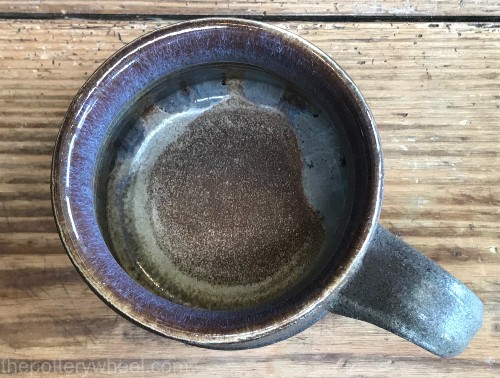
What is more, the GHK team did find after the mugs had been aged, some of them became very hot in the microwave. So, let’s take a deeper look into the question of ceramics and stoneware overheating in the microwave.
Does Stoneware Get Hot in the Microwave?
The ASTM (American Society for Testing and Materials), states that usually, a person can handle a surface that is 140F for around 5 seconds without being burned (source).
In practice, at home when you are lifting your stoneware mug out of the microwave, it’s hard to test exactly how hot the handle has become. But everyone knows what it feels like to pick something up when it’s uncomfortably hot.
It’s not uncommon for older mugs and dishes to start becoming uncomfortably hot when used in the microwave. When your stoneware is new, the glaze is most likely perfectly intact. And the underlying clay body will still be strong.
Why Does Older Stoneware Get Hot in the Microwave?
As stated earlier, stoneware is known for its strength and durability. And stoneware glazes are also tough and well-bonded to the underlying clay.
Nevertheless, with everyday use and cleaning, even stoneware can show signs of wear and tear. For example, glazes can begin to craze, fine hairline cracks can appear in joins, and surfaces can become chipped.
As this happens moisture can start to permeate the ceramics. Although stoneware has low porosity, it usually isn’t 100% non-porous. So, with time, it may be more prone to moisture absorption.
When the stoneware is heated in the microwave, the absorbed moisture heats up and makes the ceramicware hot.
As a result, your favorite stoneware mug, which used to feel fine when it was heated in the microwave, might start to feel uncomfortably hot after a few months or even years of usage.
If this happens then it’s most likely time to stop using this particular piece of stoneware in the microwave. Or alternatively, if you absolutely have to use the microwave, then it may be time to buy some new mugs.
Once, stoneware has started to become hot in the microwave, this process will only continue to worsen. The heating process will gradually continue to compromise the strength of the ceramics, and gradually your pottery will get hotter and hotter in the microwave.
Final Thoughts
If your stoneware has been made by a reputable ceramics manufacturer and is labeled microwave-safe, then it will be fine to use for heating your food and drink. However, with time even well-made stoneware will begin to lose some of its strength and integrity.
Your aging stoneware mugs and kitchenware may not fare as well in the microwave as they did when they were brand new.
Equally, if you bought your stoneware from a smaller-scale independent potter you may not feel quite so confident using it in the microwave. The potter may not have specified if it’s microwavable or not. And even if they did, you are more or less taking their word for it.
One good suggestion is always to test out your stoneware first before using it to heat food or drink. You can test a piece of stoneware by putting it in the microwave along with a small bowl of water. Run the microwave on a high setting for a minute or so and then check to see if the stoneware is comfortable to handle or too hot.
The reason you put the bowl of water in with the stoneware is to give the microwave something to ‘cook’. Running a microwave without anything that is ‘cookable’ inside, can damage your oven.
If you find the stoneware is hot after running this test, then it’s best to use an alternative cooking vessel. But if it passes the test, then it’s likely your stoneware is microwave safe and you are good to go.

